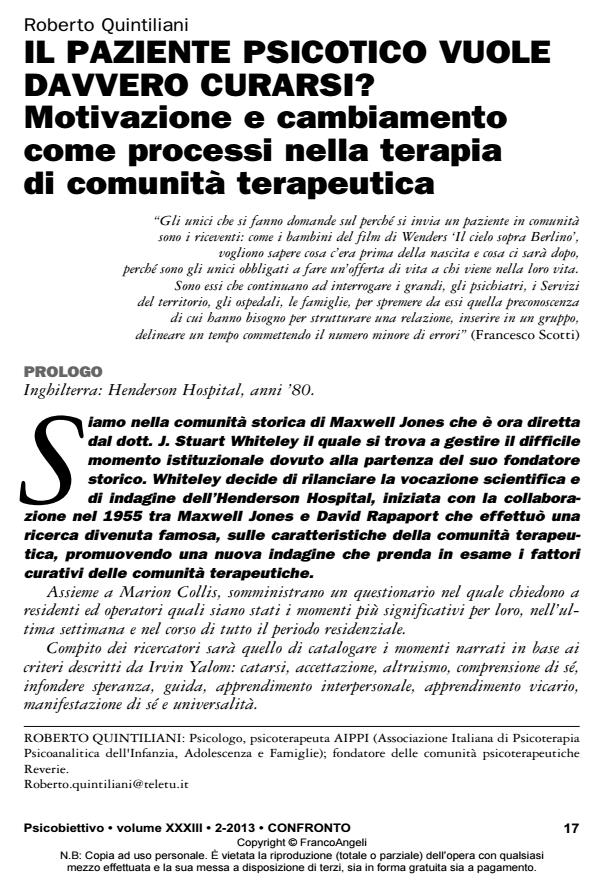Il paziente psicotico vuole davvero curarsi? Motivazione e cambiamento come processi nella terapia di comunità terapeutica
Journal title PSICOBIETTIVO
Author/s Roberto Quintiliani
Publishing Year 2013 Issue 2013/2
Language Italian Pages 10 P. 17-26 File size 122 KB
DOI 10.3280/PSOB2013-002002
DOI is like a bar code for intellectual property: to have more infomation
click here
Below, you can see the article first page
If you want to buy this article in PDF format, you can do it, following the instructions to buy download credits

FrancoAngeli is member of Publishers International Linking Association, Inc (PILA), a not-for-profit association which run the CrossRef service enabling links to and from online scholarly content.
This article examines the concepts of care and change that can be applied to a request to take charge of a psychotic patient amongst a psychotherapeutic community. The aim of the therapeutic community is that of realizing a change in the organization of the personality rather than the resolution of a psychological symptomatology. The object relations theory allows us to consider the factors of change as processes that take place through the construction of structuring internal objects that gradually replace those damaged and split in the patient’s internal world. Through a clinical example that retraces the path of insertion of a patient in a community, it is highlighted how the demand for care constitutes one of the results of a process that is based on the construction of a therapeutic relationship.
Keywords: Care; Change; Psychosis; Therapeutic Community; Therapeutic Relationship.
- Alvarez A. (1993) Il compagno vivo, Astrolabio, Roma
- Bion W.R. (1965) Trasformazioni, Armando, Roma
- Bion W.R. (1967) Analisi degli schizofrenici e metodo psicoanalitico, Armando, Roma
- Bion W.R. (1970) Attenzione e interpretazione, Armando, Roma
- Cadeddu G., Caltagirone C., D’Elia L., Di Leo G., Quintiliani R. (1996)
- “L’affido terapeutico: il modello psicodinamico e la prassi operativa integrata della Reverie”, Atti del Convegno FENASCOP, suppl. n. 1/96 Rivista Reverie
- Caltagirone C., Quintiliani R. (2000) “Cosa intendiamo oggi per comunità terapeutiche”, Rivista Reverie, dic.
- Correale A., Rinaldi L. (a cura di) (1997) Quale psicoanalisi per le psicosi?, Raffaello Cortina, Milano
- Corulli M. (a cura di) (1997) Terapeutico e antiterapeutico. Cosa accade nelle comunità terapeutiche?, Bollati Boringhieri, Torino
- Etchegoyen R.H. (1990) I fondamenti della tecnica psicoanalitica, Astrolabio, Roma
- Feinsilver D. (1996) “Il terapeuta come mentsh e il trattamento integrato della schizofrenia”, Interazioni, 2, 2003
- Fenichel O. (1951) Trattato di psicoanalisi, Astrolabio, Roma
- Meltzer D. (1971) Il processo psicoanalitico, Armando, Roma
- Quagliata E. (a cura di) (1994) Un buon incontro, Astrolabio, Roma
- Scotti F. (2003) “Perché si invia un paziente in CT”, Atti del Convegno “Come cura la comunità terapeutica”, Roma 13 giugno
- Whiteley J.S., Collis M. (1987) “The therapeutic factors in group psychotherapy applied to the therapeutic community”, Int. Journal of Therapeutic Communities, 8, 1
Roberto Quintiliani, Il paziente psicotico vuole davvero curarsi? Motivazione e cambiamento come processi nella terapia di comunità terapeutica in "PSICOBIETTIVO" 2/2013, pp 17-26, DOI: 10.3280/PSOB2013-002002